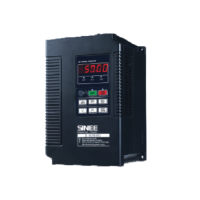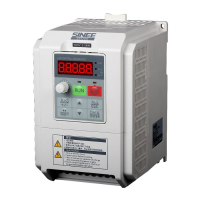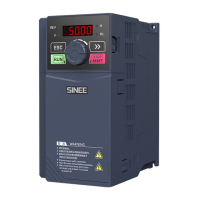Do you have a question about the Sinee EM303A-015G/018P-3CB and is the answer not in the manual?
Provides essential precautions for safe operation and installation of the inverter.
Highlights critical dangers and warnings related to electrical hazards during wiring.
Lists important cautionary notes to prevent damage or hazards during wiring.
Highlights critical dangers and cautions during trial operation.
Emphasizes dangers and precautions related to inverter maintenance and inspection.
Warns against modifying the inverter and highlights user responsibility for damages.
Explains different inverter control modes: V/F, SVC0, and SVC1.
Lists environmental conditions, temperature, and ventilation needs for installation.
Advises protective measures during installation to prevent foreign matter ingress.
Shows a diagram illustrating connections between EM303A and its peripherals.
Presents diagrams of the main circuit terminal blocks for different EM303A models.
Lists the functions of the main circuit terminals for proper connection.
Details the requirements for installing a circuit breaker on the input side for protection.
Provides instructions on connecting the inverter output terminals to the motor and checking rotation direction.
Warns against connecting power to outputs, shorting, or using capacitors/switches.
Lists the control circuit terminals available on the EM303A PCBA.
Describes the keypad layout, display, buttons, and potentiometer functions.
Provides a detailed step-by-step procedure for performing trial operation of the inverter.
Guides on connecting the motor to the mechanical load after successful idling operation.
Describes how to start the inverter with load and the initial frequency setting.
Lists general parameters, their functions, ranges, defaults, and types.
Selects the mode for PID regular setting (numeric, analog inputs, or potentiometer).
Lists various fault trip codes, their descriptions, default values, and types.
Defines program operation modes for speed, PID, and torque control, including restart options.
Explains general parameters F0-00 and F0-01 for speed and torque reference input.
Explains the requirement and purpose of autotuning motor parameters for vector control.
Lists precautions and modes (stationary/rotational) for autotuning motor parameters.
Explains automatic torque boost for maintaining speed under load by adjusting voltage.
Describes slip compensation in V/F control to maintain motor speed closer to idling speed.
Lists common trip codes, their causes, and corrective actions for troubleshooting.
Analyzes issues related to parameter setting, including unchanged values and locked parameters.
Diagnoses common abnormal motor operations like not running, wrong direction, or reversing.
Emphasizes the need for daily checks and regular maintenance to prevent failures.
| Category | Inverter |
|---|---|
| Rated Power | 1500W |
| Peak Power | 3000W |
| Model | EM303A-015G/018P-3CB |
| Input Voltage | 24V DC |
| Output Voltage | 220V AC |
| Output Frequency | 50Hz |
| Efficiency | 90% |
| Protection Features | Overload, Over Voltage, Short Circuit, Over Temperature |
| Cooling | Fan |
| Operating Temperature | -10°C to 50°C |












